Shoei Helmets Guide
Published on: 19 September 2024
CLICK SHOEI HELMETS TO SHOP WITH FREE UK NEXT DAY DELIVERY
In this review, what I want to do is talk through the 2024 Shoei helmet collection, and that's because there are some changes afoot, and we wanted to keep everybody apprised of what is going on; what helmets are being dropped, and what new models are on their way. We are also aware that not everybody understands the differences between the various models in the range, so we thought it might be useful to clarify what the different models are, what each helmet is designed to do. And for whom.
But before we do that, I wanted to talk about Shoei's helmets in general, and explain why, in our view, they're simply the best.
There are, of course, lots of different helmet brands on the market, and so to some people it can all be a bit confusing. It was much easier back in the day. In the eighties, the best stocked motorcycle stores sold every helmet brand. They sold Shoei helmets; and they sold Arai helmets!

Of course, even today these two longstanding helmet manufacturers sit head and shoulders above the rest. In terms of quality of construction, fit, comfort, reliability and protection, the other brands don't get close.
And in part this is attributable to the fact that both brands are Japanese. Arai opened its doors in 1926. Shoei is by comparison a relative newcomer, not coming onto the scene until after the war, in 1959.
But Japanese companies look at the world differently. They look at the future in terms of generations. They are not so bothered about the need to keep investors happy with the latest interim results. In this they differ to companies like AGV, Schuberth, Shark and Nolan, all of which are owned by Venture Capitalists. And these guys invest in the helmet business for one reason only. They want to grow the business as quickly as they can, flip their investments, and make a bundle!
Arai and Shoei’s longer perspectives, by contrast, mean that they have the luxury of looking to do the right thing, rather than the expedient one. To both companies the brand is paramount, clearly. Both companies stand for quality, and both believe fiercely that they produce the best helmets that money can buy. They just go about it in different ways.
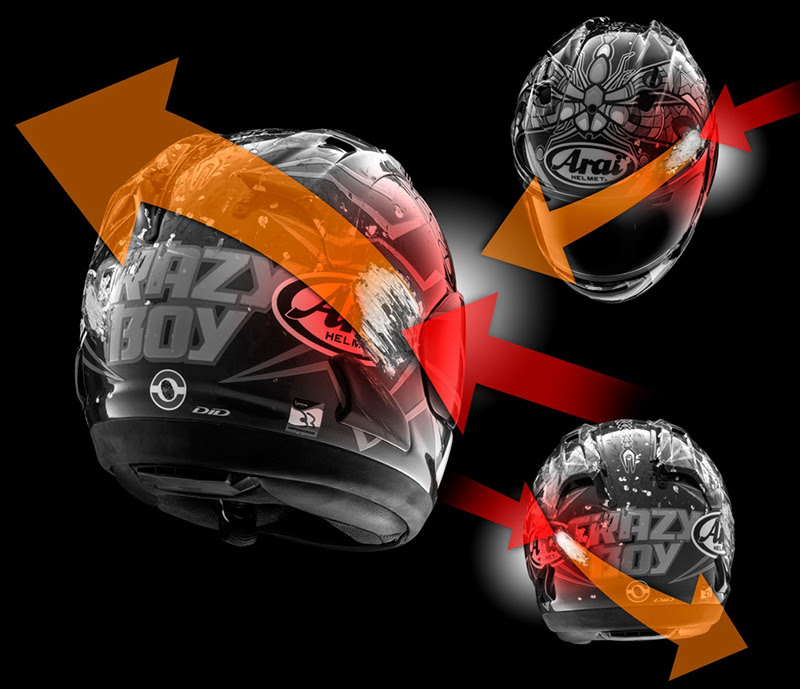
Arai is totally uncompromising. The company has a very set philosophy. Everything they do is predicated on safety. And all things considered, they do probably make the most protective helmets. They believe in smooth, round shells that bounce, or ‘glance off’, rather than dig in when they hit the ground. This can reduce the rotatational forces that can contribute to brain damage. For various, historic reasons, Arai's helmets tend to have thicker shells. These are more resistant to cracking and penetration, but they don't necessarily absorb the energy of an impact as well. Which is why Arai compensates with softer eps liners.
The bottom line is that if safety were your only concern, you'd probably only ever buy an Arai.
Now clearly Shoei is very much about protection too; and indeed the two brands set the benchmark in this regard. Between them, they were responsible for creating the latest FIM standard for international racing; a standard that, in turn, very much informed the latest ECE 22-06 protocol.

But Shoei places greater store than Arai does on what is known as 'passive safety'.
Shoei recognises that a rider has to be comfortable in a helmet if he is to ride safely, in order to avoid having an accident in the first place. And so Shoei has always worked harder than Arai, and indeed every other manufacturer, to make the fit of their helmets customisable. Of course, the ultimate incarnation of this is Personal Fitting System, Shoei's latest computer-aided fitting system.
With rideability in mind, Shoei equips some of its helmets with drop-down sun visors. To help you stay cool, they make helmets with flip-up chin bars. They care about reducing noise levels, in the way that Arai doesn't. And they make helmets with the facility to integrate a comms. facility; again in the way that Arai never would.
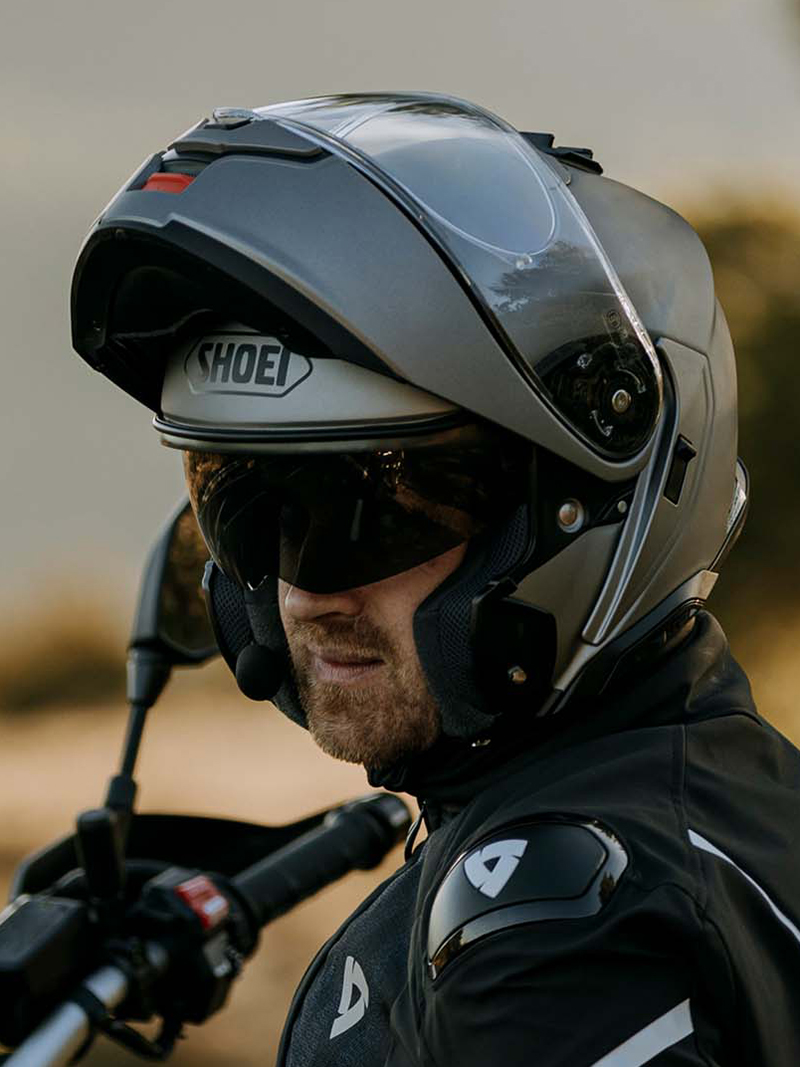
Both Arai and Shoei make great helmets. They unequivocally make the best helmets you can buy. They just go about it, as we have suggested, in different ways.
Anyway, what we want to do now is talk through all the helmets in the Shoei range. To talk about what differentiates them, and to explain what kind of rider, and for what kind of riding, each helmet is designed for. We are also going to try and give you some insights into what the future holds for some of these helmets.
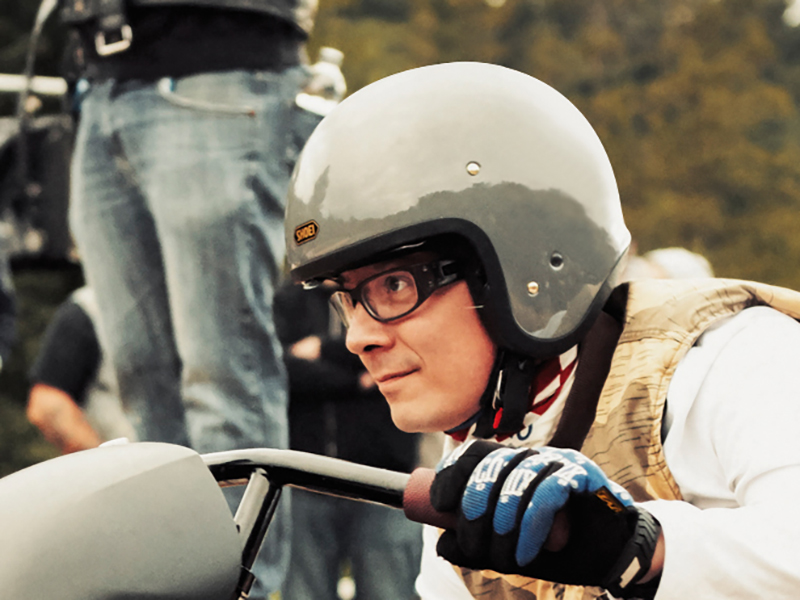
The Shoei J.O helmet
Nearly all open-face helmets are designed down to a price point, as most are aimed at the scooter market where riders want to spend the smallest amount possible to be road legal. The sweet spot for open-face helmets, I am told, is something south of £100, although you can spend a lot less.
Nearly all of these helmets will be produced in the Far East, which is where they have to come from to reduce costs. These helmets are produced in factories where batch testing is unheard of. The prototype might well have met the required standard, but as an Italian report some years ago showed, many of the helmets made in this way don't meet the standard by the time they reach Europe. And, of course, there is no independent testing of helmets. The standard is self administered. But frankly if you think your head only merits a hundred pounds worth of protection, go for it. Personally, I wouldn't; but that might just be me!
Now let me make one thing clear. We really don't like open-face helmets.
The primary purpose of a helmet is to absorb the energy of an impact, in order to slow down the movement of the brain from one side of the skull to the other. If you slow this movement down, you reduce the possibility of brain damage. And a good open-face helmet will do this every bit as well as a good, full-face helmet.
But whereas a full-face helmet will provide some protection to the face itself, an open face will provide none. You don't have to spend much time Googling on the internet to find pictures that will put you off ever riding in an open-face helmet again.
Not that long ago, at a standstill, I got hit up the rear by another bike. I went over the bars, and ended up sliding down the tarmac on my face. Luckily, I was wearing a full face helmet. It was no big deal. But had I not been, I would have spent quite some time eating my dinner through a straw.
Now the Shoei JO helmet has been around for quite a few years. As customers to the shop will know we have always tried to persuade people not to buy one, but the truth is that the JO has long been the best open-face helmet on the market. It comes in three shell sizes, is nicely padded for comfort, is equipped with a drop-down sun visor, and has the facility to accept three different thicknesses of headliner, and three different thicknesses of cheekpad.
But the JO is not much longer for this world. Shoei has decided not to upgrade the helmet to ECE 22-06, which means that once the current stocks with the UK importer have sold through, there won't be any more. We estimate, and it's just an estimate, that by the end of the year, you won't be able to find a JO anywhere.
It's a shame. We're still not a huge fan. But for those who wanted an open-face helmet, it was the best. And don't go thinking that you'll find a better open-face than the JO by spending twice the money on one. You won't!
We don't quite know why Shoei has decided to drop the JO, but the reckoning is that, with limited capacity in its Japanese factories, they prefer the idea of selling more expensive Neotecs, GT Airs and X-SPR Pros.
So, if you really do want an open-face helmet, and if you want the best, go for it. But you should probably do so sooner rather than later!

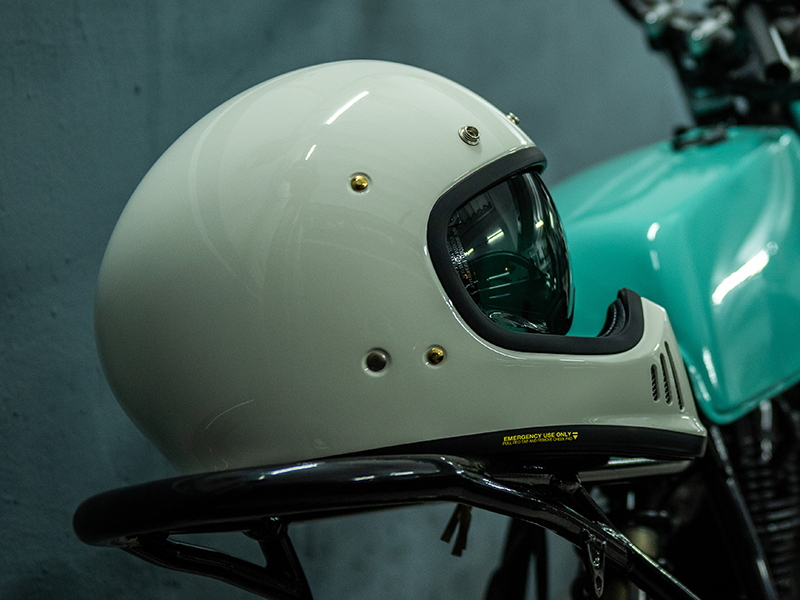
The Shoei Ex-Zero helmet
We have always liked the Shoei Ex-Zero helmet, although the reality is that, technically, the Ex-Zero is just the JO with a chin bar grafted on the front. What we like about it is that you still get a great feeling of fresh air through the large aperture, but the benefit of the Ex-Zero over the JO is that, if you do face-plant the road, you stand a good chance of walking away with your teeth in place and your visage intact.
The Ex-Zero has changeable internals like the JO, and the same drop-down, sun visor as the JO.
It's fashioned in the style of an off-road helmet, but it is very much designed for road riding. It's the kind of helmet that would look right on any kind of modern scrambler bike, although of course you can wear it on any bike.
But it's more a summer helmet than a winter one because of course, it has no outer visor. You can ride it in light rain, as long as you’re happy for the wet stuff to run down your chin. It’s not pretty, though!
You can, of course, wear the Ex-Zero with goggles. The Klim goggles fit like a glove, by the way. And a lot of people wear the EX-Zero with goggles if they're going off-road. We've already said that this isn't an off-road helmet, per se. But if you want something that passes muster both on and off the road, the Ex-Zero would serve you well.
But here's the problem. As with the JO, Shoei is not making an ECE 22-06 version of the Ex-Zero. And so, again, when the UK distributor's stocks disappear, so does the Ex-Zero. And that's a shame because we really do like the Ex-Zero. It is, in every conceivable way, superior to the Bell Moto 3. In fact, it is superior to all of the lookalikes. But soon you may have no choice.

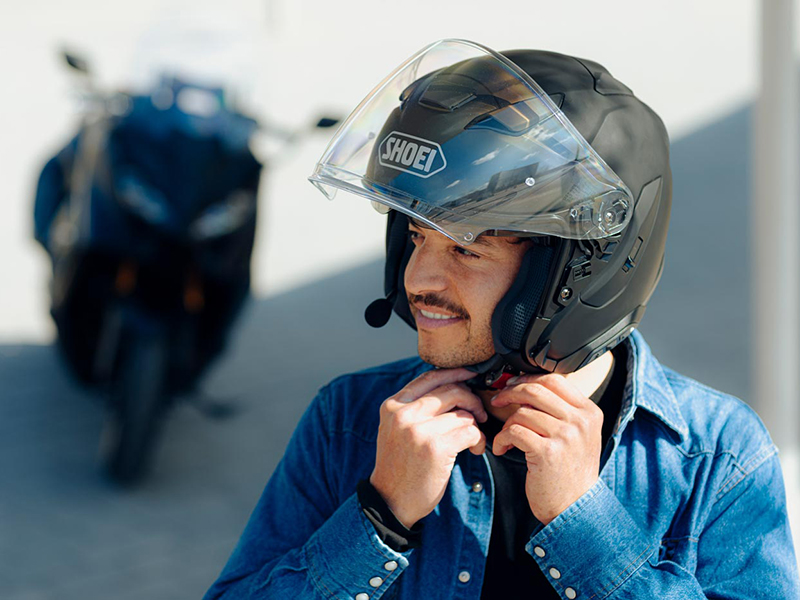
The Shoei J-Cruise 3 helmet
The Shoei J-Cruise 3 helmet is a very particular kind of lid. I think some people imagine that it combines the air-flow advantages of an open-face helmet with some of the protective advantages of a full-face helmet. But that’s emphatically not the case.
The J-Cruise is homologated as an open-face helmet only; that is to say that it is only J-rated. The helmet is basically an open-face helmet with a large screen designed to prevent flies and stones getting stuck in your teeth. Will the screen provide much in the way of protection as your face slides along the tarmac? Well, a bit maybe, but not for long we suspect, and if any force is applied the screen would simply detach from the shell.
By now you will know our feelings about open-face helmets, and so we cannot be a whole lot more enthusiastic about the J-Cruise. As a style of helmet, it seems most popular with the cruiser crowd. Hence the name, I suppose.
The reason these helmets are popular with those who ride cruisers is the fact that a lot of these bikes have large screens. And so, in hot weather, you risk getting no air flow. Without doubt, you’ll be more comfortable in such conditions, therefore, with a J-Cruise rather than something like a GT Air.
But, whatever our reservations on a protective level, if this is the style of helmet you want, the J-Cruise is the one to have.
This latest iteration, the J-Cruise 3, came out in September ‘24. It’s 22-06 accredited. And obviously, as it’s a Shoei, it comes with all the right components. So changeable cheekpads and headliners, PFS compatibility, and so on. You get a drop-down, sun visor, and the helmet is pre-channeled to take an integrated Sena comms. unit, even though these helmets are too noisy for comms. to always be very effective.
Truth be told, the latest J-Cruise is very, very similar to its predecessor. The only thing that Shoei really tells us about the new helmet is that the venting flows some 70% more air than its predecessor, although we have to say that air flow has never really been a major complaint with a J-Cruise!
So that’s about it, really. We are not mad-keen fans of the helmet, but if this is how you want to ride it has to be said that the Shoei is better than the rest. That’s the truth of it!

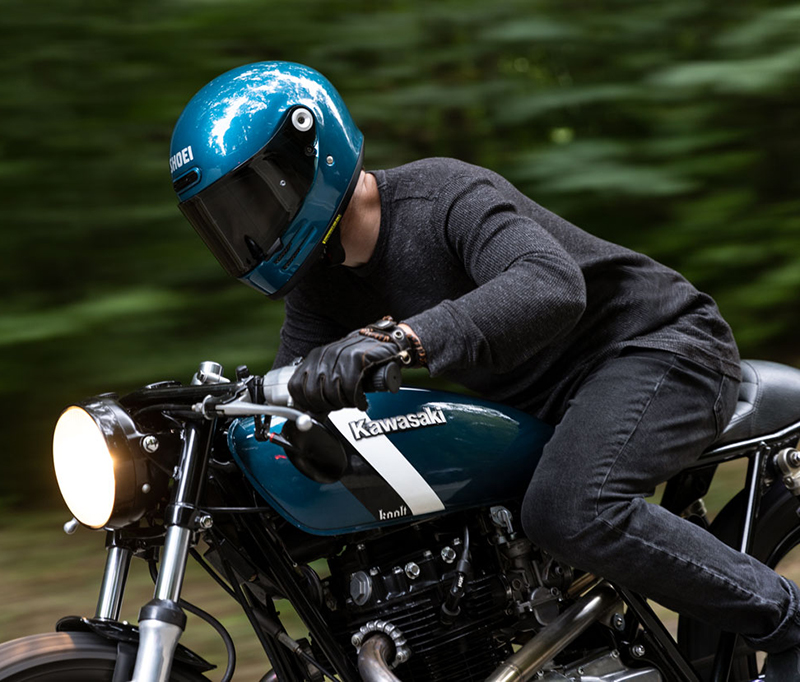
The Shoei Glamster helmet
Nobody is ever going to admit this, but we are convinced that the idea for the Shoei Glamster 06 helmet came out of a meeting we had with Shoei many years ago. They came to see us to talk about future graphics for their helmets. Frankly, we didn’t think much to any of them, but after the meeting we gave them our own presentation about the inadequate nature of most so-called, retro helmets. They seemed intrigued. They took furious notes. A couple of years later, they presented a prototype of a retro helmet at EICMA. A coincidence? Perhaps, but we’re not budging!
Now when the whole retro thing took off, most retro helmets were an exercise in style over substance. The helmet that kicked it off, of course, was the Bell Bullitt. It had dramatic looks, resembling a classic, astronauts’ helmet more than anything. In fact, the design came from an art student’s final-year, end-of-term project. The helmet was the very definition of retro. It looked amazing, and Bell got the graphics spot on. We launched the helmet at the Bike Shed show in Tobacco Dock in 2014. And for a number of years the Bullitt sold like hot cakes.
But we did go off it because the truth is that it was a pretty awful helmet. It was noisier than a salon hair dryer. It had no venting to speak of. With no seal around the visor aperture it leaked like a bucket with a hole in the bottom. And the fit was not only peculiar, but also totally unadjustable. Truth be told, however, all those who then copied the Bullitt made helmets that were even worse. And that’s why, for some years, we petitioned people like Arai and Shoei to create a retro helmet with the functionality of a modern one.
Arai eventually came out with the Concept XE; initially called the Rapide Neo. But Shoei got there first with the superlative Glamster, although we were never that enamoured of the name!
With the Glamster you got that smooth, round shell that connoted retro motorcycling style. But you got a properly sealing visor that kept the rain out, and noise down. You got reasonable, if not outstanding ventilation, you got a Pinlock 120 in the box, and the facility to change cheekpads and headliners to customise the fit.
You didn’t get a drop-down visor, because those didn’t exist in the eighties and nineties. And in the further interests of authenticity you got a double D-ring fastener rather than a micrometric one.
In truth, the Glamster was, and is, streets ahead of all the other retro helmets out there, but it is still no GT Air or NXR. The Glamster is a cool-looking helmet that raised the stakes in the retro arena, but it is still not state of the art as far as functionality is concerned. Along with the Arai, it is the best in its class, but it’s not the quietest or best vented, full-face helmet out there. It’s a helmet you wear to make a statement. You probably wouldn’t tour or commute in one, unless of course looking the part was really, really important to you!

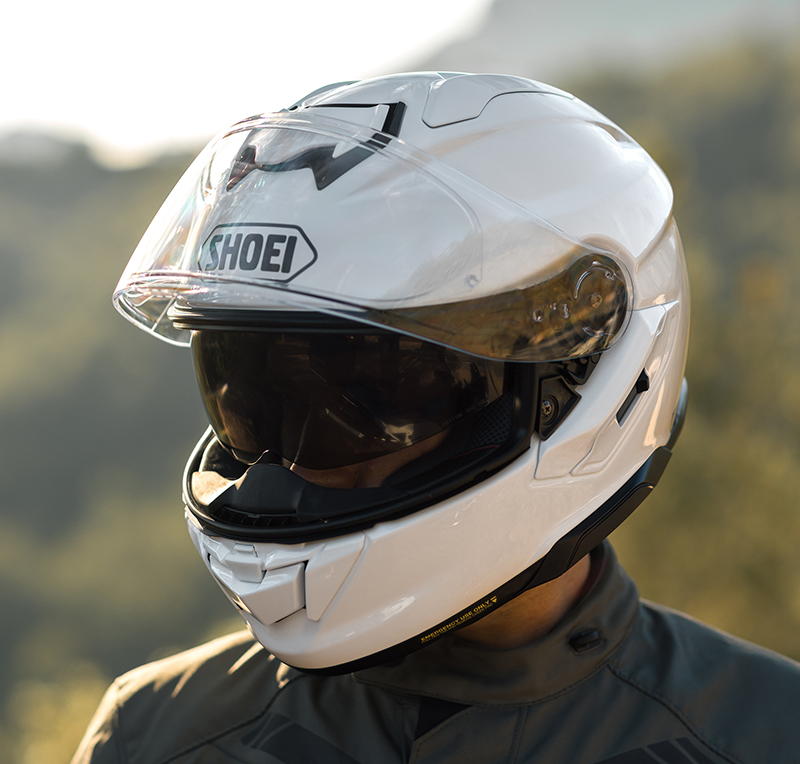
The Shoei GT-Air 3 helmet
The GT Air is Shoei’s longstanding, full-face, sport-touring helmet. The current model is the helmet’s third iteration and, as you would expect, most people in the industry rate it as the best such helmet you can buy.
It’s the sport-touring helmet that all the other manufacturers try and copy. Indeed, there are lots of helmets out there that are like the GT Air, but cheaper. But those helmets are not GT Airs. They are cut-price versions of it. Lots of these will come in two shell sizes only, as opposed to the Shoei’s three. They won’t have the Shoei’s changeable, internal parts, they won’t have the integrated comms. facility of the Shoei, and of course they won’t be as well made. They will have been produced to a price rather than a quality.
A sports-touring helmet is the kind of helmet that you can wear on just about any bike. You might not choose one for an out-and-out race bike, although a helmet like this would be perfect if you ride one of those sportsbikes with upright handlebars. A sport-touring helmet would look right on an adventure bike, provided you hadn’t convinced yourself that you needed a peak. You might fancy something more overtly stylish, but a Shoei GT-Air 3 helmet would also work fine on a cruiser, custom or retro bike. The Shoei GT Air is the helmet that does everything. It will never be out of place, whatever you ride.
As a helmet, it comes with a drop-down visor and a facility for an integrated, Sena SRL-03 comms. unit.
It’s a difficult helmet to find fault with, although we kind of think that the next Shoei we’re going to talk about is, for most people, actually a better helmet.

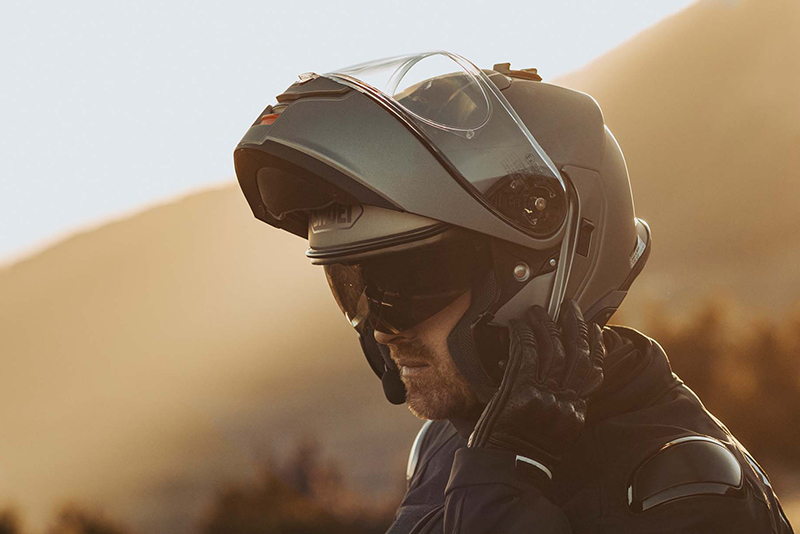
The Shoei Neotec 3 helmet
The Shoei Neotec 3 is a flip-lid helmet. It is far and away the best-selling flip-lid on the market . In fact, with the huge increase in interest in flip helmets in recent years, the Neotec is the best selling, premium helmet in the world. There are probably helmets that sell in greater numbers in, say China, where millions of people ride small capacity bikes, but at the upper end of the market, dominated by the better known Japanese, American and European brands, the Neotec stands on the top step of the podium.
Now flip lids do not appeal to everybody. Old-school prejudices die hard. But attitudes are changing, and so you’ve got to be pretty hard-core obdurate these days not to appreciate the many benefits of a flip helmet.
A flip lid is easier to put on, and take off. You can lift the chin bar to talk to the attendant at the petrol station. In hot weather, when you're riding through a town or village at low speed, you can do the same to get cool air on the face. If you have an accident, and are lying by the side of the road, a first responder can get to your airways in the way they can't with a full-face. (It takes two, fully-trained people to remove a full-face helmet, and sometimes there's only one person on the scene).
And, of course, a good-quality, flip helmet is quieter than a full-face helmet. The Shoei Neotec 3 helmet, therefore, is somewhat quieter than its closest cousin, the GT Air. There's a good reason for this, and we have explained it fully in our video for the Neotec 3 that you can click here to watch.
And so, as a company, we get to a position where we cannot see why you would go for a full-face, sport-touring helmet like the GT Air over a Neotec. We see no downsides. We see only benefits.
As we have suggested, those who don't like flip helmets are normally motivated by prejudice. Honestly, we don't get it. When the Neotec is closed, from five metres you cannot tell that it's not a full-face helmet. You still don't like flips? All I can say is: “Get over yourself”!
Now the Neotec 3 has just one credible competitor. It's the Schuberth C5 helmet, but in truth it's not quite in the same league. It is not as well built and put together. It comes in just two shell sizes, meaning that there's a huge gulf between the L and XL sizes. We can change the internals to customise the fit a little, but for some bizarre reason we can only do so on three out of the six sizes. The C5 is a very good helmet, but in our view the Neotec is a great one. This having been said, those with rounder heads might just find the Schuberth fits them better out of the box.
As with all Shoeis, you get the option of changeable cheekpads and headliners; and of course there’s always PFS if you want a perfect fit. The comms. facility is pretty much plug and play, although it’s got to be said that the C5 has a comms. unit that’s even easier to install. All the other stuff on the Neotec is what you might expect at this end of the market. Good venting. Pinlock 120. And so on.
The truth is that, in recent years, flip lids have become far more widely accepted. You can wear one on any bike, although a flip still looks wrong on a sportsbike, in our opinion. And a flip doesn’t exactly embody retro cool!
But in terms of comfort, functionality and usability a flip is where it’s at. The Neotec 3 is the best flip you can buy. Does this make it the best helmet you can buy? Well, for most riders, the answer is probably yes.

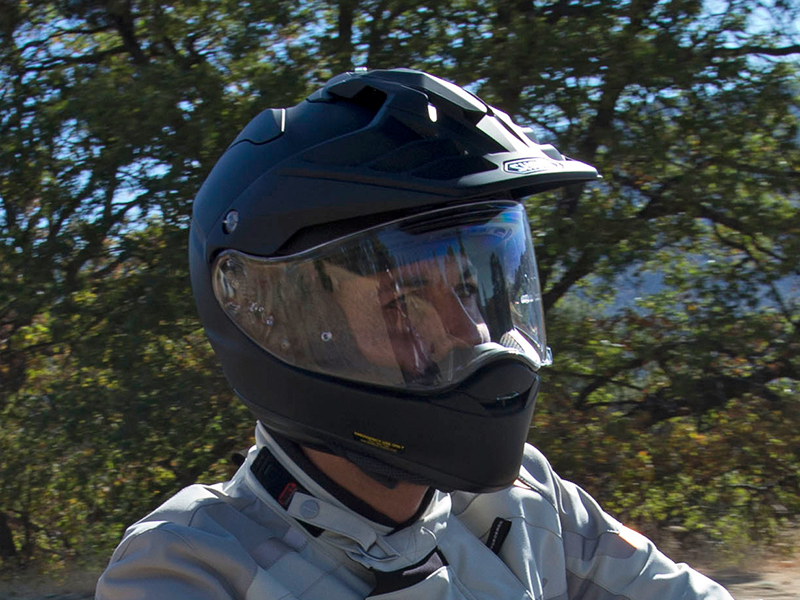
The Shoei Hornet ADV helmet
In recent years, the world has gone a bit adventure bike mad. And we understand why. The adventure bike is the bike that can do pretty much anything. You can commute on one, tour on one, ride off road on one, go out for a bacon bap on one. I’ve even seen guys on track on an adventure bike. And they don’t embarrass themselves there either.
But when someone is new to the adventure bike world, they often convince themselves that they cannot be seen out on such a bike unless they have a helmet with a peak.
Actually, we think that’s usually a mistake. We understand as well as anybody the dictates of style, but for those who spend most of their time on the road a helmet with a peak can be a pain in the neck. Literally! It adds little, but it can create turbulence and will add noise. People talk about using the peak to block out the low sun, and at dusk in the Serengeti we might agree, but most road riders would be better off with a drop-down sun visor which, of course, you don’t tend to get with an adventure helmet.
Now the Hornet is a classic adventure helmet; and it’s a good one with all of the quality and fit benefits you might expect from a Shoei. It is a direct competitor to the somewhat more famous Arai Tour-X5 helmet which, in its fifth incarnation, is 22-06 accredited.
And that is important because the Shoei Hornet ADV helmet is still only ECE 22-05. It’s the only ongoing helmet in their range not yet upgraded, and we can’t really understand why it hasn’t been upgraded, as the adventure market is where it’s at right now.
As we write this article, in mid September 2024, the current Hornet has almost sold out. And that’s what we might expect as no helmet manufacturers have been allowed to produce 22-05 helmets since June 2023.
All well and good, but given this situation we would have expected its replacement to hit the market very soon. But here’s the thing. There will not be another new Shoei until the Spring of 2026. It would seem, therefore, that there won’t be a Shoei adventure helmet on the shelves for a good 12-18 months!
Shoei doesn’t make mistakes with its timings, so what is going on? The bottom line is that we don’t really know, but our best guess, based on nothing more than rumour and conjecture, is that Shoei has had a re-think at some point. And so they have gone back to the drawing board.
There are two possibilities that seem plausible to us.
First, the new Hornet is going to be a flip lid. And this is not totally ridiculous. Schuberth has the E2, which is notionally a flip-lid with a peak, although truth be told it’s actually more a touring helmet with a peak than an adventure helmet with one. All things considered, though, we think this development is unlikely!
Another possibility is that Shoei has gone back to the drawing board in an attempt to integrate a drop-down, sun visor into the new Hornet. We know that this is what a number of Shoei’s distributors around the world have asked for, so it’s certainly not out of court.
There would be some challenges here, though, and that’s because a classic adventure helmet has a ‘pointy’ chin. And it’s this shape that dictates the profile of the visor. Now you can get away with this with the external visor, although to avoid distortion you need a good-quality one. But an angled sun visor is another matter. It would not be impossible to make it work but, as we have said, it would be a challenge.
The naked truth is that we have absolutely no idea what is going on. We can only hope that when the new Hornet does come through it was worth waiting for!
Where we get to, right now, is that we have little enthusiasm for selling the current Hornet. If you like Shoei, and want an adventure helmet you’d be best off waiting, if you can. We are not going to stop anybody buying the current Hornet, but in the shop we will be telling everybody that they’re not getting the latest safety standard.


The Shoei NXR2 helmet
We really like the Shoei NXR2 helmet. It would be a stretch to call it a sport-touring helmet. Such a helmet would normally have a drop-down sun visor, and certainly Shoei itself considers the NXR to be more of a sports helmet. And you can tell this because they have given it a double-D ring strap fastener.
What we like about it is that it’s really light. Now lightness is always a good thing, provided there are no trade-offs, and with the NXR we cannot see any. It’s comfortable, it’s quiet, it has a really large visor, the venting is good, and so on.
The downside, as we have suggested, is that you don’t get a drop-down sun-visor with the NXR. But that partly explains the helmet’s size and lightness. You could always go for a Transitions visor that darkens in the sunlight if you wanted some protection from the sun. That would mitigate the problem, but the cost of a Transitions visor for the NXR is astronomical.
A few years ago, the NXR was priced very similarly to the GT Air. Now, on one level, that made the NXR look quite expensive in terms of its features. But about a year ago, Shoei brought the price down, and this was largely in response to calls from retailers wanting what might be termed more of an entry-level Shoei. There had been a helmet called the RYD, and it was brilliant. It was simple, inexpensive, and introduced a lot of people to the world of Shoei. When the helmet was withdrawn from the market, that left Shoei without an offering that allowed motorcyclists to get a foot on the Shoei ladder.
Lowering the price of the NXR bridged the gap a little, but it leaves us feeling that the NXR is now a bit of a bargain. Okay, no Shoei is ever going to be cheap, cheap, but with the NXR you get a high-end helmet for somewhat less than high-end money.
All the other stuff on the NXR is as you might expect although, interestingly, it’s the only helmet in the range to come in four shell sizes.
Finally, its smaller dimensions, and lighter weight, mean that the NXR is often popular with ladies. Personally, if you don’t need all the bells and whistles, we think it’s a brilliant helmet.

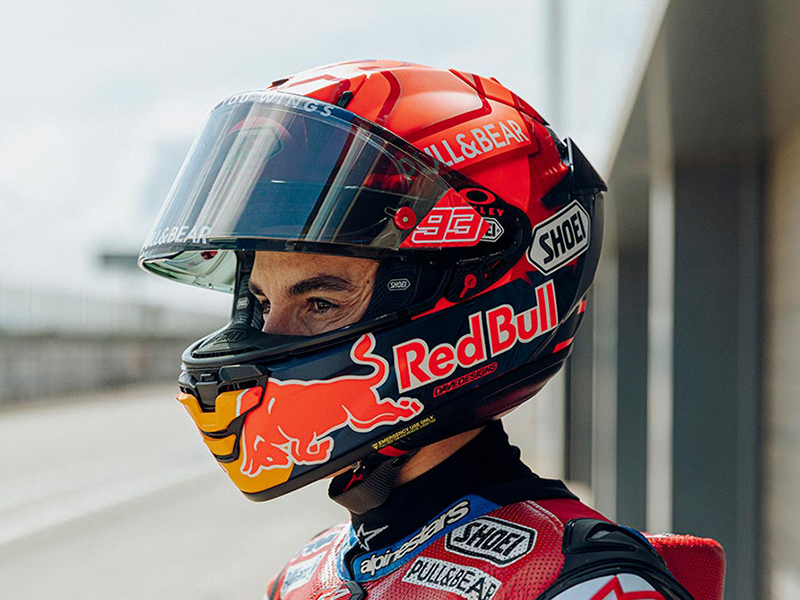
The Shoei X-SPR Pro helmet
Shoei helmets have always been popular with motorbike racers. The Shoei X-SPR Pro is an out-and-out race helmet. It’s the helmet worn by all of Shoei’s sponsored riders in MotoGP, in WSB, in BSB and at the Isle of Man. It’s the Shoei you’d buy if you were serious about track days, but it’s also popular with well-heeled superbike owners.
Frankly, it’s not really a Motolegends kind of helmet. We don’t sell one-piece leathers. Or two-piece leathers. Indeed, we have almost nothing here for sportsbike riders. But we have become the people on PFS, and there are lots of Shoei X-SPR Pro helmet owners out there who wanted to be able to get a proper custom fit, we were told, and so we were persuaded to take the helmet on.
There will be people who want an X-SPR Pro because it is lightweight, trick and very expensive. But if you don’t spend most of your time lying on the tank of your bike at high speed this is not the helmet for you.
The X-SPR Pro has a harder shell than other Shoeis, as it is formed with an additional, sixth layer. The helmet was very much formed in the wind tunnel, such that Shoei reckons it’s totally stable at over 200 mph. The visor is super-large for a race helmet. You also get road and race modes with the fit, to give you a better view down the road when you’re tucked in. The visor has two locking mechanisms to make sure it doesn’t open even in an accident. The venting is terrific, although it will not work anywhere near as well if you are upright on a sit-up bike.
But what differentiates the X-SPR Pro from any other Shoei is that it comes with a totally unique headliner that is formed of five, separate pads that then velcro to one another. Now that means there’s a great deal of adjustability, but you need to have all the PFS pads on hand. And we don’t see how you can even make a start on getting it to fit properly if you haven’t been through a PFS fitting session.
We still don’t reckon we’re going to sell a whole lot of X-SPR Pros, although we do have them all here in the shop. But the truth is that if you want an X-SPR Pro, and want it to fit properly, and to work as it should, you should perhaps come and see us. After all, there’s nowhere that a good fit is going to count as much as it does on the race track.

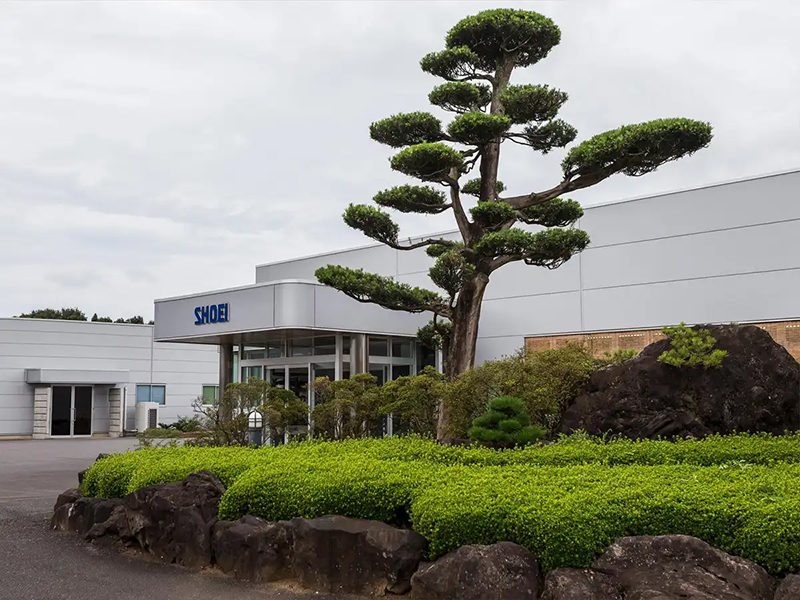
In summary
Shoei is in the final throws of transitioning its helmets from 22-05 to 22-06. As we have seen, most have already made the move. The Hornet is still some way away. Sadly, it looks as though we are going to lose the JO and the Ex-Zero.
Here at Motolegends, of course, we are Shoei fans. We revere Arai. We admire their staunch adherence to their founder’s philosophy, and Arai does make some terrific, and very protective, helmets.
But Arai’s helmets are uncompromising. Shoei’s helmets, by contrast, are accommodating. For ‘real world’ riding where comfort is important, where noise is important, and where we have got used to conveniences such as flip-up chin bars and integrated comms., then it has to be acknowledged that there’s nothing out there that gets close to a Shoei.
They may not be the cheapest. But they are the best!
You can buy Shoei helmets with free next day UK delivery online, or visit our store in Guildford to try it one on.
Share this story
































































